Alan Cathcart | August 25, 2018
More Of the Same, But Better?
We test Benelli’s new adventure tourer
Just one year ago, Benelli launched the 500cc parallel-twin TRK 502 adventure tourer produced in China by its owner Qianjiang/QJ. It’s since been a global sell-out, with 7000 examples delivered in Europe in the past year, and 15,000 versions around the world—though not yet in the USA. (Be patient, though, it’s coming.) Well-equipped and evidently well-engineered, judging by the positive posts on social media from so many of its customers, the Chinese-built twin is lot of motorcycle for the money, costing just Euro 5990 in Italy, including 22% tax. That’s approximately $6800-plus U.S. dollars.
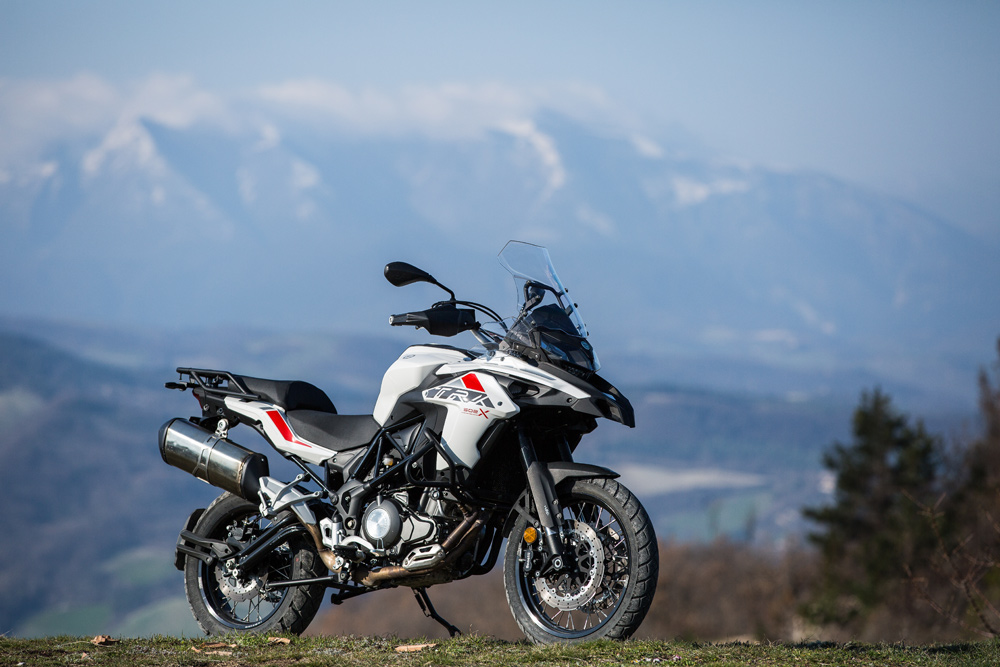 Benelli’s new twin-cylinder 500cc parallel-twin adventure tourer is developed in Italy but built in China by owner Qianjiang/QJ.
Benelli’s new twin-cylinder 500cc parallel-twin adventure tourer is developed in Italy but built in China by owner Qianjiang/QJ.
Now this strong-selling tarmac-focused version has been joined by the TRK 502X, a more ruggedly equipped true dual-purpose bike selling for the same low price as its sister model, and available in white, black and red. Jointly developed in Italy and China by Benelli and QJ technicians, its manufactured in China to reduce costs leads to that crucial edge on price. The chance to ride this latest variant of Benelli’s twin-cylinder success story over a grueling route in the Apennine mountains, including off-road along Italy’s famed strade bianche white dirt roads, allowed me to compare and contrast it with its predecessor.
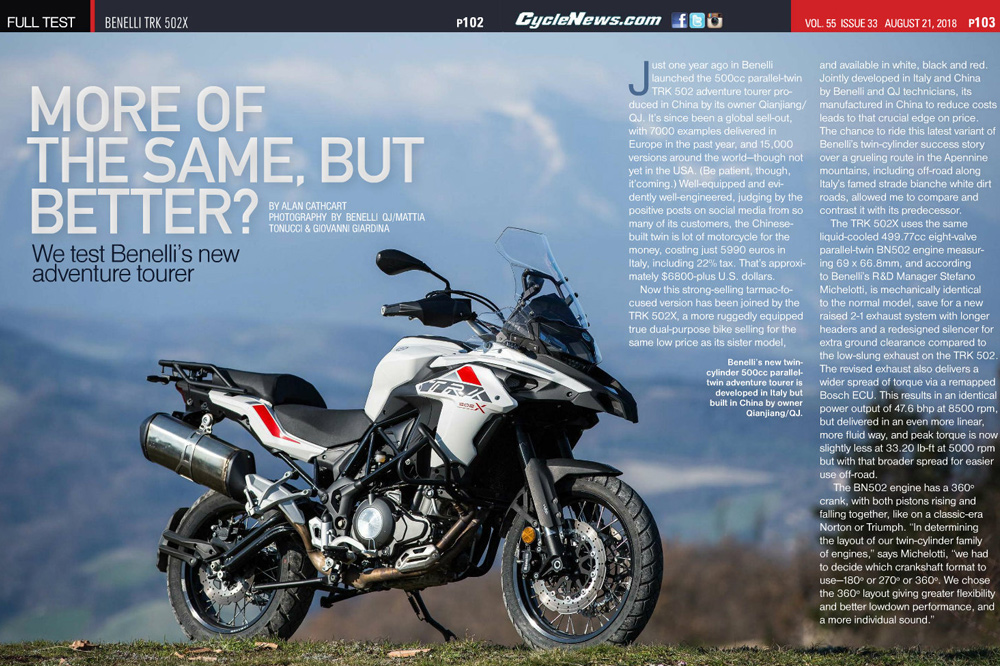
PHOTOGRAPHY BY BENELLI QJ/MATTIA TONUCCI & GIOVANNI GIARDINA
The TRK 502X uses the same liquid-cooled 499.77cc eight-valve parallel-twin BN502 engine measuring 69 x 66.8mm, and according to Benelli’s R&D Manager Stefano Michelotti, is mechanically identical to the normal model, save for a new raised 2-1 exhaust system with longer headers and a redesigned silencer for extra ground clearance compared to the low-slung exhaust on the TRK 502. The revised exhaust also delivers a wider spread of torque, via a remapped Bosch ECU. This results in an identical power output of 47.6 bhp at 8,500 rpm, but delivered in an even more linear, more fluid way, and peak torque is now slightly less at 33.20 lb-ft at 5000 rpm but with that broader spread for easier use off-road.
The BN502 engine has a 360º crank, with both pistons rising and falling together, like on a classic-era Norton or Triumph. “In determining the layout of our twin-cylinder family of engines,” says Michelotti, “we had to decide which crankshaft format to use—180º or 270º or 360º. We chose the 360º layout giving greater flexibility and better lowdown performance, and a more individual sound.”
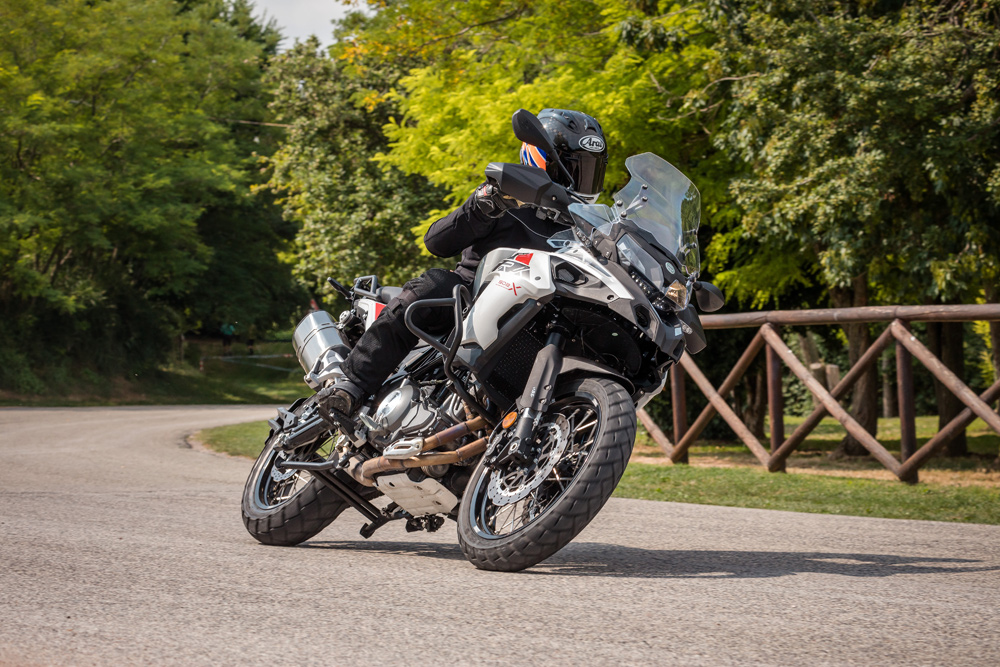 The 502X’s tubular steel spaceframe, plus Chinese-made suspension and brakes deliver light, precise handling with good ride quality, now that the previous flawed rear suspension has been fixed.
The 502X’s tubular steel spaceframe, plus Chinese-made suspension and brakes deliver light, precise handling with good ride quality, now that the previous flawed rear suspension has been fixed.
The resultant short, compact wet sump engine’s cylinders are inclined forward by 20°, sitting on robust-looking crankcases. The double overhead camshafts are chain-driven up the left side of the engine, with the paired 25mm inlet valves and 22mm exhausts. Compression ratio is 11.5:1. With a cable throttle rather than ride by wire (RBW), there’s no choice of riding modes, nor any other electronic rider aids beyond the Bosch ABS required for Euro 4 compliance. Simple is best, is the QJ mantra, which at such a low price point is surely acceptable. Fitted with a single injector for each of the twin 37mm throttle bodies made in-house by QJ in China, the Benelli’s parallel-twin engine weighing 143.3 pounds without throttle bodies carries a single counterbalancer positioned in front of the crankshaft, and gear-driven off it.
This results in a jewel of an engine that’s uncannily smooth once you thumb the starter and it booms into life, settling to a high 1400 rpm idle speed with a very individual audio soundtrack for today, via the 2-1 exhaust’s single silencer exiting on the right behind you. This Benelli sounds like a modern Chinese-built Italian re-interpretation of a classic British 500cc parallel-twin of yesteryear with a 360º crank—something the current Triumph Bonneville and Norton Commando don’t provide, with their 270º pseudo-V-twin crank throws. And thanks to that balance shaft there’s zero adverse vibration at any revs on the TRK 502X.
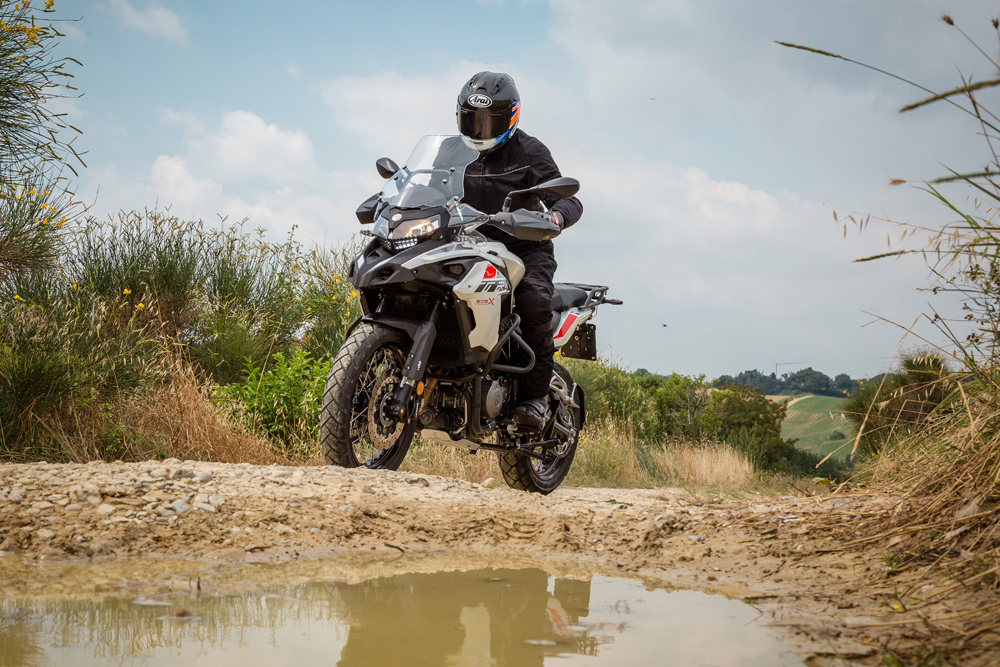 Substantial and spacious, the Benelli TRK 502X offers real world rideability and has genuine off-road potential along dirt roads and hillside tracks.
Substantial and spacious, the Benelli TRK 502X offers real world rideability and has genuine off-road potential along dirt roads and hillside tracks.
Initial pickup is even better from low down because of the remapped fuelling, and also because Benelli has geared the X-model down by adding two extra teeth on the rear sprocket for a 14/44 overall ratio, versus 14/42 before. That’s with the same curb weight of 518 pounds (469.6 pounds dry) with a full 5.3 gallon fuel tank (which Benelli claims delivers a 310-mile range) on both models. The weights are unchanged even with the heavier exhaust because Benelli no longer delivers the bike ready fitted with mounting frames for the optional GIVI luggage, as on the TRK 502.
The TRK 502X’s 49/51% rearward weight bias comes via the 19-inch front wheel now fitted, replacing the tarmac bike’s 17-incher. The 3.00-inch front aluminum rim carries a 110/80-19 Metzeler Tourance tire, with a 150/70-18 on its 4.25-inch rear. These wire wheels replace the TRK 502’s cast aluminum ones, so they’re no longer tubeless. The larger front delivers a subtle change in the steering geometry, with the non-adjustable 50mm upside-down fork more kicked out at a 26º rake with 125mm of trail (versus 25º and 95mm before). These conservative numbers deliver stability on fast tarmac sweepers, without sacrificing agility in tighter turns or off-road, despite a still lengthy 59.3-inch wheelbase, .79 inches shorter than the street bike’s.
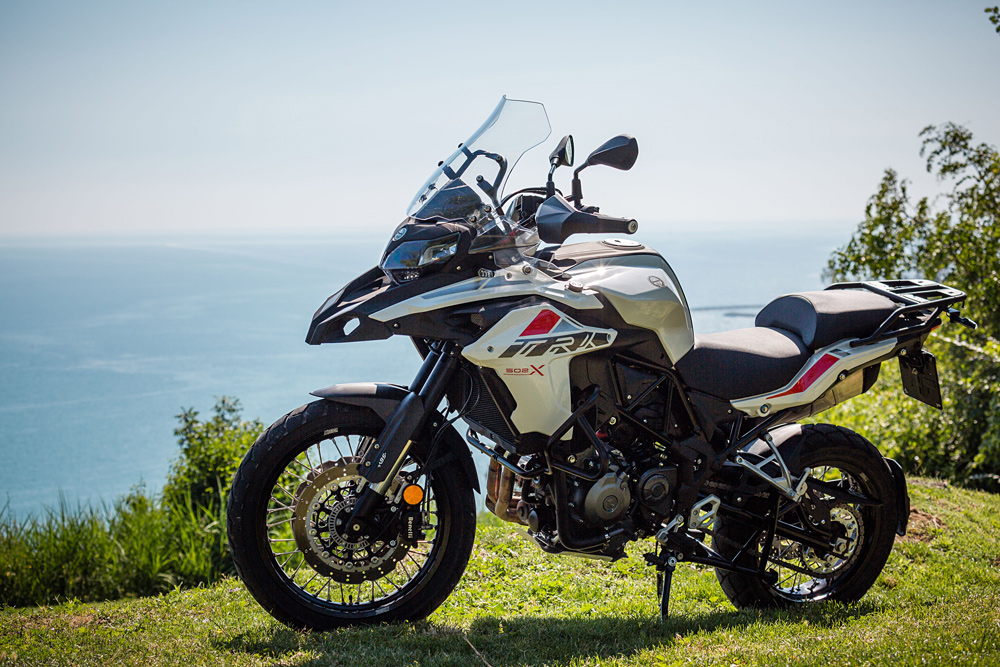 The Benelli has sharp styling and excellent build quality.
The Benelli has sharp styling and excellent build quality.
The sweet-shifting Japanese-quality six-speed gearbox’s quite closed-up ratios have 60 mph in top gear calling for 5500 rpm, and the comfortable cruising speed of 75 mph delivered at 6500 rpm (100 mph arrives with the engine revving at 9000 rpm). Okay, acceleration is a little leisurely thanks to the TRK 502X’s relatively porky weight, so overtaking requires you to kick it down a gear or two, and wind on the throttle. But its happy operating zone of 4000-6500 rpm means that with torque peaking at 5000 rpm, you’re best off using the gearbox to ride the torque curve, rather than chase the horsepower numbers. The engine struggles a little to build revs fast beyond the seven grand mark, and with peak power delivered at 8500 rpm it’s better to short-shift and make best use of what torque is provided. But the X-version of the BN502 engine is extremely flexible and forgiving, making it almost irrelevant which gear you throw at it. It pulls wide open in top gear from just 2500 rpm all the way to the 10,400rpm limiter, which you won’t ever hit in real world riding on this dual-purpose motorcycle. The oil-bath clutch’s action is light and very controllable, making this a bike you’ll enjoy riding off-road and also in cities, where your left hand won’t cramp up in traffic.
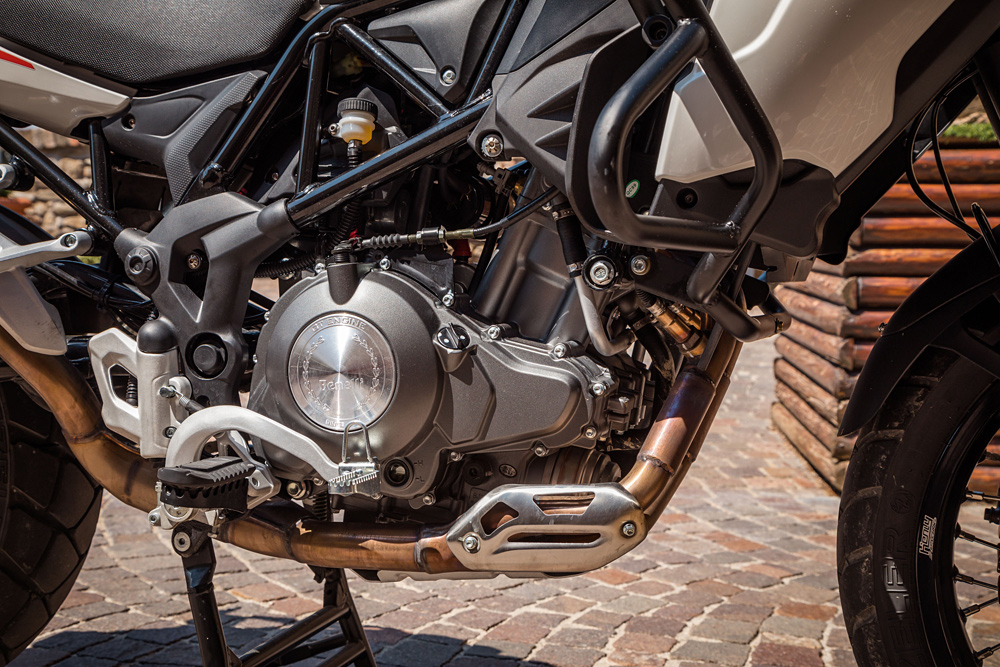 The TRK 502X is fitted with a 500cc parallel-twin engine with 69 x 66.8mm dimensions and 360º crankshaft and dispenses a broad spread of torque via a linear power delivery.
The TRK 502X is fitted with a 500cc parallel-twin engine with 69 x 66.8mm dimensions and 360º crankshaft and dispenses a broad spread of torque via a linear power delivery.
The TRK 502X employs an open-cradle trellis-style tubular steel space frame quite like a Ducati’s, with the engine employed as a semi-stressed component. There’s superior rider protection with a large fairing and substantial screen, which while non-adjustable comes with a four-inch taller option, and there are separate perspex lower deflectors either side. At 850mm high, the seat on the X-bike is 50mm taller than on its tarmac sister, resulting in a more spacious riding position without making you feel you’re perched on the Benelli—you still feel you’re sitting in it rather than on it. The standard screen was ideal for my 5’10” stature, with no helmet buffeting at speed.
According to Michelotti, Benelli QJ has retained the same self-made 50mm fork as on the original TRK 502, now with slightly softer springs and reduced compression damping in pursuit of more compliant off-road use. It felt well damped, with good feedback from the front Metzeler, and no chatter even over some of the broken road surfaces I encountered, and despite the 19-inch front wheel now fitted, the steering didn’t feel much slower, just light and predictable. At the rear, the twin-tube swingarm operates a rear monoshock via a variable link generating 6.8 inches of wheel travel on the X-bike (versus 5.9 inches on the TRK 502). It’s adjustable for spring preload via a C-spanner, and for rebound damping via a 40-click adjuster ring at the base of the shock. This was far more compliant on the X-bike I rode than the one in the TRK 502 I sampled a year ago, both on-road and off, but ride quality on road was much better, with no sign of it skipping and chattering over poor road surfaces like before. And off-road, the suspension was almost plush, with the Tourance rubber hooking up well on dirt roads. The rear suspension compliance in soaking up road rash and delivering traction off-road helps deliver the reassuring sense of togetherness I got from riding this bike.
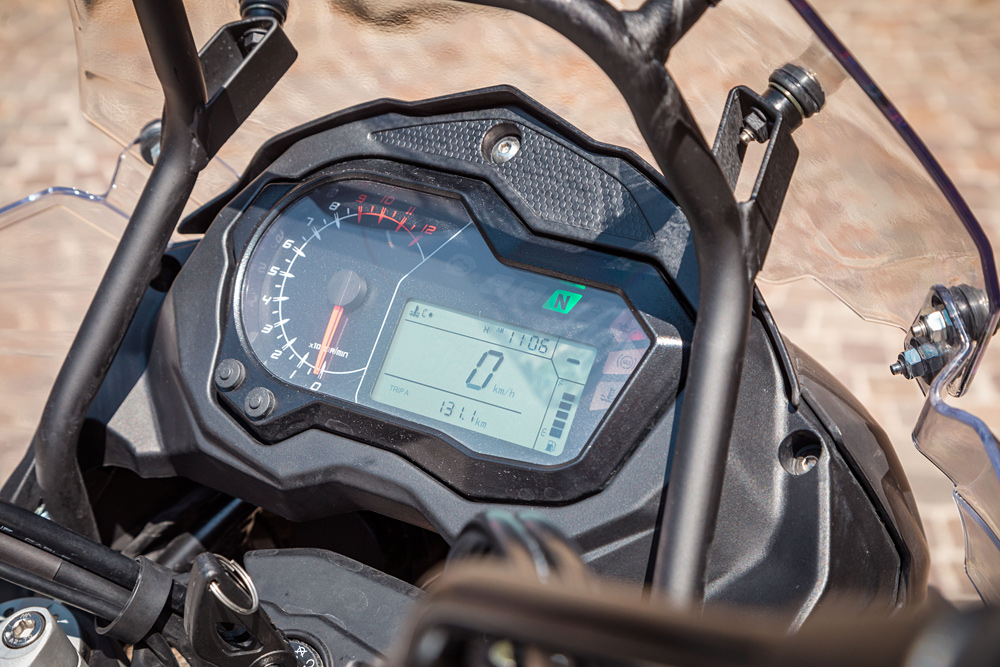 Nothing fancy here but instrumentation is plentiful.
Nothing fancy here but instrumentation is plentiful.
The TRK 502X’s twin 320mm floating QJ front discs are gripped via a four-way adjustable lever by conventional twin-piston calipers (versus four-pot radial ones on the TRK 502), and these work well within the context of the bike—they’re effective when they need to be, without an excessively hard pull on the lever. And the problems I incurred on the TRK 502 with a rear brake that hardly functioned have been resolved on this model—the twin-piston caliper and 260mm disc at the rear worked just fine. The Bosch China ABS wasn’t too obtrusive when it kicked in on the dusty roads, and can be switched off for use off-road.
The TRK 502X’s wide taper-section steel handlebar has pulled-back grips that deliver a fairly upright but still comfortable stance, with hand guards as standard. The light-action cable-operated clutch’s progressive pickup will make the Benelli easy to ride for less experienced bikers. Although you’re high enough to see ahead over car roofs to plot a course in traffic, you still feel seated within the Benelli as an integrated part of the whole package, with your knees tucked in nicely to the flanks of the capacious fuel tank. Such a stance is a key factor in promoting rider confidence, especially for novice riders—you feel at one with the Benelli, and despite the taller seat, I could touch both feet down at stoplights. The well-designed dash for this price level has an analogue tacho and digital speedo, plus water temp, fuel gauge, clock, mileage and twin trips, plus a gear selected indicator that’s very legible, like the whole dash. The front position lights, rear light and all direction signals are LED, and have evidently been inspired by a close look at the Rizoma catalogue! Besides the kick-out side stand there’s now a center stand fitted, which was absent on the TRK 502. This doesn’t look like a cost-cutting motorcycle.
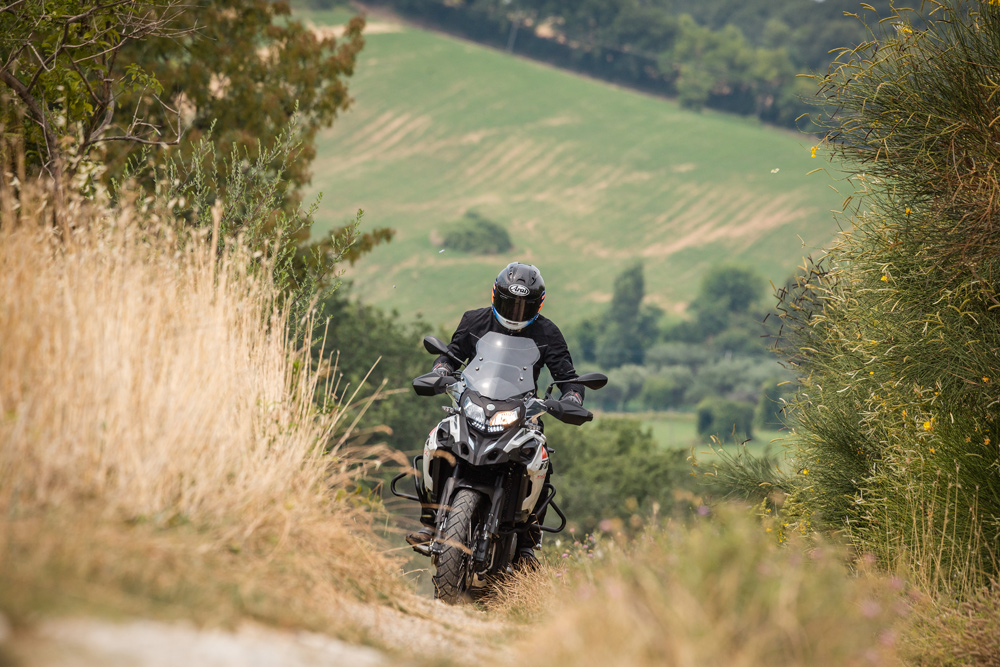 The engine is well engineered, refined and flexible, making the TRK 502X quite comfortable both on and off the road.
The engine is well engineered, refined and flexible, making the TRK 502X quite comfortable both on and off the road.
Indeed, the TRK 502X is, once again, a lot of motorcycle for the money, whose engine’s massive flexibility also makes it so easy to ride, and an excellent step up from a learner bike. It’s an affordable, accessible adventure tourer suitable for riders with all levels of experience, from returnees to newbies, who risk being daunted by the sheer size and complexity of so many such bikes today. With its restrained but perfectly adequate engine performance, it’s intelligently designed and fun to ride, whether on or off road. The build quality is now on a level with its Japanese competitors, and the favorable opinion of current owners of its tarmac-focused predecessor augurs well for reliability, and maintenance of residual value. This isn’t one of those Chinese-made bikes from not so long ago where you threw it away after a couple of years—if it lasted that long. This Benelli TRK 502X has both substance and presence, a true dual-purpose go-anywhere motorcycle, whose versatility is matched by its accessibility for all levels of riders, as well as being female friendly. It has no serious challenger in its segment while representing—yes, a downright bargain.
Bravo, Benelli!CN
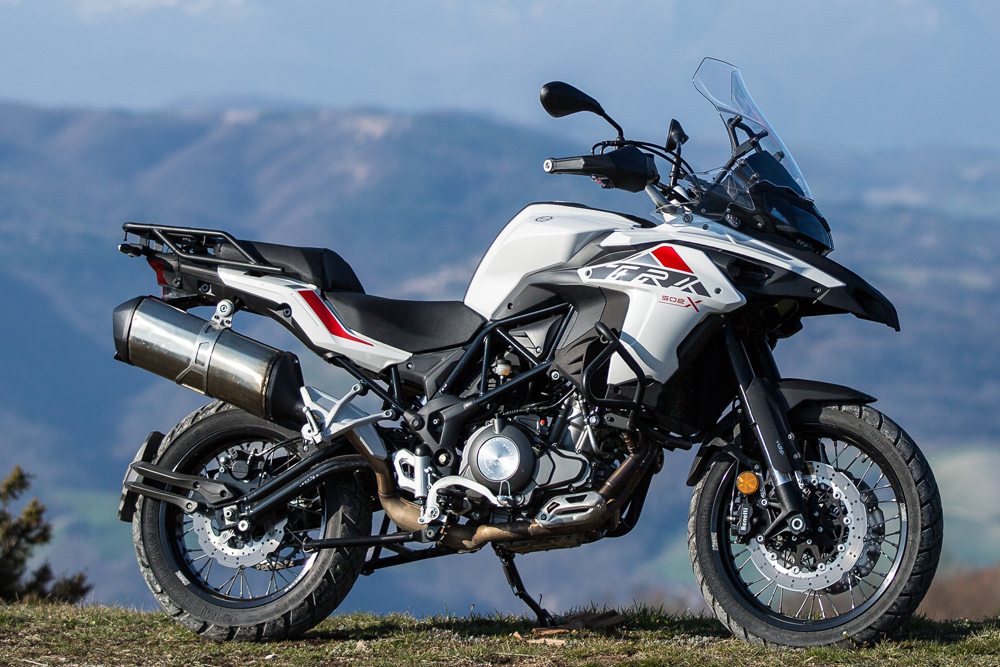
| SPECIFICATIONS |
2018 Benelli TRK 502X ABS (MSRP N/A) |
| ENGINE TYPE: |
Liquid-cooled, 4-stroke, 4-valve, DOHC, in-line, twin |
| DISPLACEMENT: |
500cc |
| BORE X STROKE: |
69mm x 66.8mm |
| COMPRESSION RATIO: |
11.5:1 |
| RATED OUTPUT: |
35 kW (47.6 Cv) @ 8500 rpm |
| MAX TORQUE: |
45 Nm(4.6 kgm) @ 5000 rpm |
| LUBRICATION: |
Forced lubrication with wet sump |
| FUEL SUPPLY: |
EFI with double throttle body, 37mm |
| EXHAUST SYSTEM: |
2-into-1, with catalytic converter and oxygen sensors |
| CERTIFICATION: |
Euro 4 |
| CLUTCH: |
Multidisc, wet |
| TRANSMISSION: |
6-speed |
| FINAL DRIVE: |
Chain |
| IGNITION: |
ECU-TLI |
| SPARK PLUG: |
NGK CR8E |
| STARTING: |
Electric |
| CHASSIS: |
Trestle steel tubes, plates |
| FRONT SUSPENSION: |
USD, 50mm, telescopic fork |
| REAR SUSPENSION: |
Swingarm, with central shock absorber, spring preload, hydraulic rebound and compression setting adjustable |
| FRONT WHEEL TRAVEL: |
145mm |
| REAR WHEEL TRAVEL: |
172mm |
| FRONT BRAKE: |
Dual disc, 320mm, with floating 2-piston caliper, ABS |
| REAR BRAKE: |
Single disc, 260mm, with single piston floating caliper, ABS |
| FRONT RIM: |
19 x 3.00 in. DOT-D |
| REAR RIM: |
17 x 4.25 in. DOT-D |
| FRONT TIRE: |
110/80-R19 in. M/C 59V |
| REAR TIRE: |
150/70-R17in. M/C 69V |
| SEAT HEIGHT: |
33.5 in. (31.5 in. optional) |
| WHEELBASE: |
59.3 in. |
| GROUND CLEARANCE: |
8.7 in. |
| WEIGHT (wet): |
518 lbs. |
| FUEL CAPACITY: |
5.3 gal. |